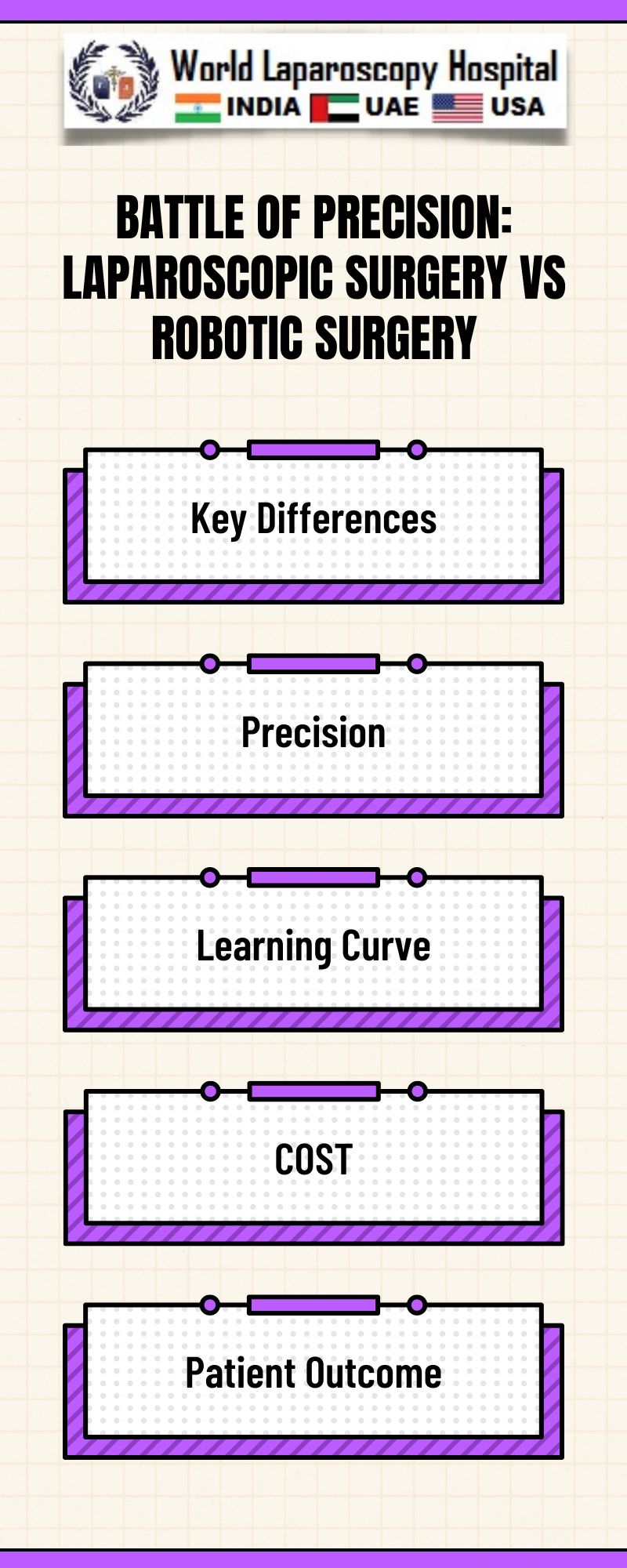Introduction:
The field of surgery has witnessed remarkable advancements over the years, with minimally invasive techniques revolutionizing the way operations are performed. Among these, laparoscopic surgery and robotic surgery have emerged as leading options, offering patients reduced pain, shorter recovery times, and improved outcomes compared to traditional open surgeries. Both approaches are known for their precision and effectiveness, but they differ significantly in terms of technology, technique, and outcomes. This article explores the battle of precision between laparoscopic surgery and robotic surgery, highlighting their similarities, differences, and the factors that influence their choice in modern surgical practice.

Overview of Laparoscopic Surgery:
Laparoscopic surgery, also known as minimally invasive surgery, involves making small incisions in the abdomen through which a laparoscope and specialized surgical instruments are inserted. The laparoscope is a thin, flexible tube with a camera and light source that allows the surgeon to view the internal organs on a monitor in real-time. The surgeon then performs the surgery using the images captured by the laparoscope, guiding the instruments to manipulate, cut, or remove tissues as required.
One of the key advantages of laparoscopic surgery is its minimally invasive nature, which results in smaller incisions, reduced blood loss, and faster recovery times compared to traditional open surgery. Additionally, patients experience less pain and scarring, leading to improved cosmetic outcomes. Laparoscopic surgery is commonly used for procedures such as cholecystectomy (gallbladder removal), appendectomy, and hernia repair, among others.
Overview of Robotic Surgery:
Robotic surgery, on the other hand, is a more advanced form of minimally invasive surgery that utilizes robotic systems to assist surgeons in performing complex procedures with enhanced precision and control. The da Vinci Surgical System is one of the most well-known robotic surgical systems, comprising a console where the surgeon sits, a patient cart with robotic arms, and a high-definition 3D vision system.
During a robotic surgery, the surgeon sits at the console and manipulates the robotic arms, which are equipped with surgical instruments, to perform the operation. The system translates the surgeon's movements into precise actions, offering greater dexterity and range of motion than human hands. The 3D vision system provides a magnified, high-definition view of the surgical site, allowing for more accurate tissue manipulation.
Robotic surgery has several advantages over traditional laparoscopic surgery, including improved precision, reduced tremors, and better access to hard-to-reach areas. It is often used for procedures such as prostatectomy, hysterectomy, and colorectal surgery, where precision is crucial.
Comparison of Laparoscopic Surgery and Robotic Surgery:
While both laparoscopic surgery and robotic surgery are minimally invasive techniques that offer significant benefits over traditional open surgery, they differ in several key aspects, including technology, technique, and outcomes.
Technology:
Laparoscopic surgery relies on handheld instruments manipulated by the surgeon, aided by a camera system for visualization.
Robotic surgery uses robotic arms controlled by the surgeon, offering greater precision and range of motion than laparoscopic instruments.
Robotic surgery also features a high-definition 3D vision system, providing a detailed view of the surgical site.
Technique:
In laparoscopic surgery, the surgeon directly controls the instruments and performs the procedure based on visual cues from the laparoscope.
In robotic surgery, the surgeon sits at a console and controls the robotic arms, which mimic the surgeon's hand movements with greater precision.
Precision:
Robotic surgery is often considered more precise than laparoscopic surgery due to the robotic system's ability to filter out hand tremors and provide a stable, controlled motion.
Laparoscopic surgery, while precise, may be affected by factors such as surgeon fatigue and hand tremors, which can impact the accuracy of movements.
Learning Curve:
Robotic surgery has a steep learning curve, requiring surgeons to undergo specialized training to master the use of the robotic system.
Laparoscopic surgery also has a learning curve but may be more accessible to surgeons with experience in traditional open surgery.
Cost:
Robotic surgery is typically more expensive than laparoscopic surgery due to the cost of the robotic system and the need for specialized training.
Laparoscopic surgery is generally more cost-effective, making it a more accessible option for many healthcare facilities.
Outcomes:
Both laparoscopic surgery and robotic surgery have been associated with similar outcomes in terms of postoperative complications, recovery times, and patient satisfaction.
Some studies suggest that robotic surgery may lead to shorter hospital stays and reduced blood loss compared to laparoscopic surgery, but the differences are often minor.
Conclusion:
In conclusion, both laparoscopic surgery and robotic surgery are valuable tools in modern surgical practice, offering patients minimally invasive options with excellent outcomes. While robotic surgery offers enhanced precision and control, it comes at a higher cost and requires specialized training. Laparoscopic surgery, on the other hand, is a more accessible option that provides comparable outcomes in many cases. The choice between the two techniques depends on various factors, including the surgeon's expertise, the complexity of the procedure, and the patient's specific needs. As technology continues to advance, both laparoscopic and robotic surgery are expected to play an increasingly important role in improving surgical outcomes and patient care.